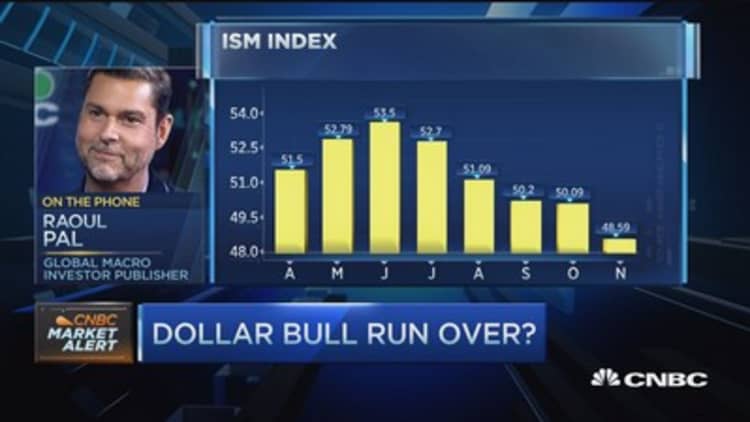
The U.S. dollar had its biggest one-day decline this week in nearly six years after the European Central Bank surprised the world with a smaller-than-expected stimulus package.
Despite the move, one prominent market observer said the dollar will continue to get stronger — and the U.S. economy will only get worse.
Although the November jobs report that showed the U.S. economy generated a net 211,000 new positions, Raoul Pal, the publisher of The Global Macro Investor, reiterated his bearishness ahead of a widely expected interest rate hike by the Federal Reserve in mid-December.
"The economic situation is deteriorating fast. And meanwhile the Fed seems to want to raise interest rates into that, which I think is a bit of a policy mistake and I think the market is getting more and more concerned from not understanding why they're doing it," Pal told CNBC's "Fast Money" last week.
Read More Philly Fed's Harker: Fed risks losing credibility
Appearing on CNBC in November 2014, Pal correctly called the the dollar's bull run. Since then, the U.S. currency has surged by about 12 percent, with most of its gains coming at the expense of Europe's common currency. He expects that trend to continue.
"This is not the end [of the dollar's bull run]" Pal said. "It's a washout of position and too many expectations around the ECB."
'65 percent chance'
But it's not just the strong dollar that has Pal fearing the worst for the U.S. and global economies.
Some figures are painting a pessimistic view of future growth. Last week, the Institute for Supply Management said its manufacturing index fell below 50 last month, indicating a contraction in the industrial sector. The survey's participants cited low growth in Europe and China as impacting business, as well as a drag from the strong dollar.
The report "is showing that the U.S. economy is almost at stall speed now," Pal said. "It gives us a 65 percent chance of a recession in the U.S. I think much of the world is already in recession. Europe's not there yet, but it will come in due course."
Pal said history suggests a low ISM often portends downturns in the U.S. economy. Although manufacturing is a relatively limited slice of the U.S. economy, economists still believe the sector is a barometer of growth.
"That [65 percent] number comes from using the ISM survey, and every time it has crossed 50 since 1948 gives you a 65 percent chance of a recession," Pal said. He added that Fed chair Janet Yellen could not dismiss the implications of a weak figure "because the ISM correlates perfectly with U.S. GDP. Even though manufacturing is a smaller share of the economy, it is still a perfect predictor of GDP."
However, Yellen expressed a very different view on Thursday.
"When we put it all together we're still seeing an overall picture of slightly above trend growth, ongoing improvements in the labor market," she said in congressional testimony. "Obviously there are risks that come from the global environment that we have monitored carefully, but overall we're on a solid course."
But Pal said the ECB and the Fed are to blame for the market's volatility.
"There is so much mis-signaling by central banks that no one knows what on earth to do. I think that's creating enormous volatility in the markets," Pal said. "And I think the central banks need to get their act together and get better signaling because the markets are so confused what's going on right now."



